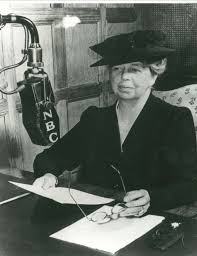Far and wide, over this country, I have said that for generations to come, there would be people using the things created by WPA workers during this period of depression. The sad part of it is that, of course, few people will realize who built the schools, or the parks, or the playgrounds or the recreation centers.
—Eleanor Roosevelt, My Day, August 1939
Imagine writing a 500-word newspaper column six days a week, some of them while serving as First Lady. Eleanor Roosevelt’s syndicated column, My Day, which ran from 1936 until 1962, appeared in 90 newspapers in all parts of the country and, at its height, reached an audience of more than four million.
Inviting her readers into the White House, ER’s column told them about what she did as First Lady, introduced them to her family and friends, and offered her impressions of books, concerts, and plays. Chatty and informal, My Day nonetheless was imbued with ER’s inimitable humanitarian perspective. Later, “on her own,” she wrote about serving as U.S. delegate to United Nations and framing the Universal Declaration of Human Rights.
As First Lady Eleanor was a great proponent of the New Deal programs that provided jobs to millions of unemployed workers while greatly expanding and enriching the nation’s resources. Nowhere is this more apparent than in My Day, where she reported on her nationwide travels to visit projects undertaken by the Works Progress Administration (WPA), Civilian Conservation Corps (CCC,), Public Works Administration, (PWA), and National Youth Administration (NYA).
Here are a few examples:
March 10, 1936, Detroit: I set out to visit some WPA projects. First, the project where immunization against whooping cough is being studied….Then we went to another project, a municipal garage which will be a tremendous building…. this project is being supervised by the city engineers and the work was considered as good as any contract work.
November 13, 1936, Milwaukee: I have just come back from one of the most interesting mornings I have ever spent…. a handicraft project for unskilled women…They are binding scrap books for children; books to be used in hospitals; and books for the Braille project….

Visiting New Deal projects
In 1937, first lady Eleanor Roosevelt helped lay the cornerstone for WPA project in Montgomery County, Kentucky.
March 21, 1937, Austin I went out to see a roadside park, one of the NYA projects that has proved most successful in this state. They have built one hundred and sixty-six of these parks….
March 17, 1938, Los Angeles … the Fresno airport… has been greatly improved by WPA labor…some of the buildings have been moved and the administration building has been built. Then we drove through the park to see the artificial lake the WPA has constructed.
February 13, 1939, Washington, DC… a visit I paid to the new Department of the Interior building to look at the murals. Henry Varnum Poor’s mural of wildlife is a grand piece of work. You almost feel that you are walking right into the scene and that the men and birds are alive…. Don’t fail to see them if you are in Washington.

The First Lady on the air, 1941
In addition to her newspaper column, she reached millions through her weekly radio address.
For many years, the memory of these projects and its workers faded– as Mrs. Roosevelt feared they would. Thanks to the Living New Deal, the public is being made aware of these enormous contributions. May such recognition lead us to recognize that our great gaps in infrastructure, environmental sustainability, human services, and access to culture could once again be filled by men and women in need of living-wage work.

